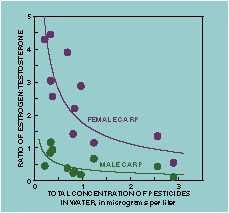|
STANDARDS AND GUIDELINES FOR PROTECTING WATER QUALITY
Water-quality standards and guidelines generally are
maximum acceptable concentrations of pesticides for protecting humans,
aquatic life, or wildlife. They are established by the United States and
other nations, international organizations, and some States and tribes.
For this report, precedence was given to standards and guidelines established
by the USEPA and then to those established by Canada or the International
Joint Commission for the Great Lakes, although some states may have different
standards and guidelines that take priority for particular water bodies.(25)
Drinking-water standards or guide-lines have been established
for 43 of the 76 pesticides analyzed, and aquatic-life guidelines have
been established for 28 of the 76 pesticides. Aquatic-life or wildlife
guidelines are available for 8 of the 16 pesticides (compounds or groups)
analyzed in bed sediment or fish.
Current standards and guidelines do not
completely eliminate risks because: (1) values are not established for
many pesticides, (2) mixtures and breakdown products are not considered,
(3) the effects of seasonal exposure to high concentrations have not been
evaluated, and (4) some types of potential effects, such as endocrine
disruption and unique responses of sensitive individuals, have not yet
been assessed
|
Most pesticides are manufactured compounds that are designed to kill
specific pests, such as weeds and insects. Many pesticides have the potential
to harm nontarget organisms, especially if the organisms are exposed to
high levels or for a long period of time. In the early 1960s, Rachel Carson's
widely publicized book "Silent Spring"(32)
described the ecological impacts of DDT and other pesticides. Concerns
about the unintended effects of pesticides continue to this day, and evaluation
of the risk to humans and the environment from present-day levels of pesticide
exposure remains highly controversial.
A difficult aspect of evaluating potential effects of pesticides is determining
what may occur as a result of varying types and durations of exposure.
Exposure is complicated by pesticide mixtures, breakdown products, strong
seasonal concentration pulses, and high concentrations during stormflows.
In contrast, most toxicity assessments are based on controlled experiments
with a single contaminant over a limited range of concentrations.
Although uncertainties remain, water-quality standards and guidelines
have been developed for many pesticides in order to protect human health
and aquatic life, and they are used in this report to signal potential
problem areas. Concentrations that exceed a standard or guideline, however,
may not be a problem at some sites. Conversely, the absence of an exceedance
does not ensure that there is no problem.
Some people believe that any presence of pesticides in their drinking
water is too much, whereas others feel that the standards and guidelines
established for many of the major pesticides provide adequate protection.
Which of these perspectives is closest to the truth remains unclear, but
certainly the effects of common patterns of pesticide exposure found in
NAWQA studies have not yet been fully evaluated.
The uncertainty in whether or not present-day levels of pesticide contamination
are a threat to human health or aquatic life makes it imperative that
we understand the nature of exposure, the causes of contamination, and
the actions we can take to reduce pesticide levels in streams and ground
water. Only by accurately characterizing the nature and causes of environmental
exposure can we develop effective strategies to minimize exposure and
reliably evaluate relations between exposure and effects.
|
